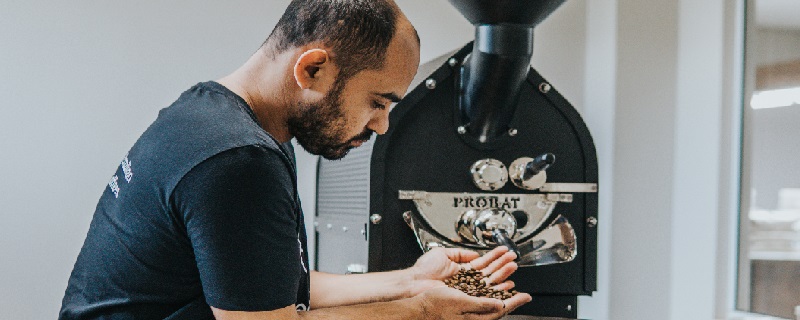The coffee bean goes through several stages until it becomes the drink that everyone knows. One of these steps is called “roasting,” which is the fundamental burning process to acquire the specific characteristics of the drink. It is responsible for determining many of the coffee’s characteristics, such as acidity, body, balance and final flavor.
At high temperatures, the beans’ flavors and aromas are developed, revealing its unique characteristics. The same coffee bean will have different characteristics depending on the type of roast used. That’s why it’s important to be familiar with all types of roast and how each one of them influences the coffee flavor.

Light-roasted coffees: They do a better job at preserving the coffee’s acidity and floral aromas. This type of roast is most used for delicate and high-quality coffees. Light roasting develops little of the coffee’s body, so the beans do not present much bitterness. Additionally, it also conserves most essential oils, once the longer the roast, the more bean oils are lost.
Medium-roasted coffees: It seeks the balance point of the coffee’s characteristics, where it acquires proportional acidity, sweetness, bitterness and body. Due to the intense caramelization of sugars and the decomposition of natural acids, the bean reduces essential oils, its intense acidity, aroma and flavors. It also gains more body and has a hue that goes from brown to red. The result of this roast is a harmonious drink, which leaves a long sweet finish.
Dark-roasted coffees: In this type of roast the beans begin to darken. It is imperative that they are watched closely to avoid burning the beans and having an unpleasant final drink taste. This type of roast produces a stronger coffee with more bitterness to it. However, it is not full-bodied and it is less acidic, having a slight sweetness to it. The beans develop a dark color, with brownish tones. Its flavor refers to chocolate and caramel, and it is the type of coffee that Brazilians are most used to drinking. It is ideal for those who want a strong coffee, with a robust flavor and intense aroma.
We also have the so-called “burnt coffees,” which are very dark roasted. At this level, the coffee loses its aroma, body and acidity, which makes it a poorly flavored coffee. This type of roast can be used to mask the defects of low quality coffees, or for an error when roasting. To assist in this process and prevent this from happening, there are Agtron discs, which are placed side by side with the beans. This way, it is possible to compare the colors and identify if a coffee is too light or too dark.
Each disc represents a stage of the roast and serves to avoid extremes (too light or too dark), as very light coffees may end up not revealing their full flavor and aroma potential, while very dark coffees end up burning and losing their quality.
There is no correct roast, as it will depend on the result one is looking for. High quality coffees go well with lighter roasts, while coffee with more imperfections needs to be roasted longer. It is important to be attentive during the process to avoid having too much raw coffee or burn the beans.
The coffee industry has recently started to avoid using the terms “light, medium and dark” only, when talking about roasting. It is increasingly necessary to know whether a roast is developed or not. After it is well developed, the roast can have a lighter or darker tonality. To define the profile of a particular coffee, we can make use of other characteristics, such as color, weight loss and roasting duration. You can also sort them based on the final approach: roast for strained or roast for espresso.
Do you know why it is important to separate the roasts of brewed and espresso coffees? These two methods of preparation are very different in essence. When making espresso coffee, for example, you force pressurized hot water through an amount of compact coffee. As it is a very short extraction, it is necessary to use very thin ground coffee.
With brewed coffee, it is possible to use a coarser grind, as a greater volume of water absorbs the compounds in its own time and pressure. This results in less acidic coffee and less body compared to the espresso coffee, even if you use the same beans.
As dark roasted coffee is more porous than light roasted ones, medium and dark roasts are more soluble and extracted faster. That allows them to be used in different preparation methods. You can adjust some roasting variables but, in general, light roasts work best with a slower extraction method (such as brewed coffee), and darker roast works best with a fast method (such as espresso).
Brewed coffee highlights the individual flavor notes of a coffee, therefore filter roasting should focus on preserving its specific characteristics. Generally speaking, the longer the bean spends in the roasting development phase, the more body the coffee will have, but the acidity and fruitiness will be damaged.
We can also highlight the quality of the OMNI roast. Here, the coffee beans are roasted so that they can be prepared in any way. This type of roast allows the beans to become soluble enough that it works out with espresso coffee, preserving a variety of aromatic compounds and allowing the coffee to have a balanced flavor in any method of preparation.
The types of roasting are decisive factors in the aroma formation and final flavor characteristics of any coffee drink. However, it is important to point out that each bean has its own peculiarity and behaves differently during the roasting process. That is why it is important to be careful when selecting the bean and the type of roasting.
If you already have your favorite type of roast, purchase our best Brazilian specialty coffee beans now. Our coffees have gone through several processes, such as: Honey, Natural, Aerobic Fermentation and Pulped Natural.



